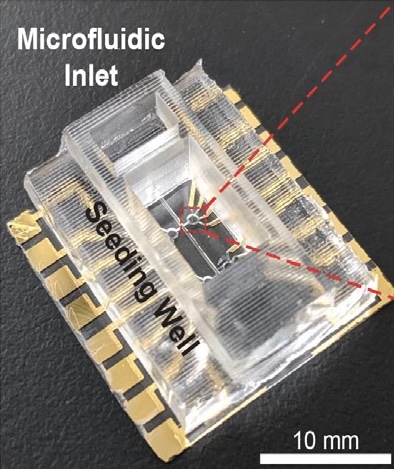ERC Team Develops Heart-on-a-Chip with Integrated Sensors
Outcome/Accomplishment
The NSF-funded Nanosystems Engineering Research Center (ERC) for Cellular Metamaterials (CELL-MET), led by Boston University, has developed a versatile 3D heart-on-a-chip platform with integrated mechanical stimulators and sensors. The platform enables controlled experiments on functional cardiac tissue and a greater ability to monitor results.
Impact/Benefits
Recreating functioning cardiac tissue for disease modeling and diagnostics requires the ability to apply stimulus in a controlled environment. The Center's innovative platform allows both the growth and stimulation of cardiac tissue, as well as the ability to monitor tissue response on multiple levels.
Explanation/Background
The ERC team's heart-on-a-chip platform enables cardiac tissue to be grown and tested in a highly controlled environment that mimics the natural habitat of heart cells. The device consists of multiple microchambers and microchannels imprinted on a layer of polymer that is sealed by bonding to another material, normally a glass slide. The chambers can be filled with cardiac microtissue and cell media for testing. Integrated mechanical stimulators and sensors allow for long-term and higher levels of monitoring.
Heart disease is the number one cause of death in the United States and a leading cause of death worldwide. This innovative technology can be used to test a number of cardiac-related therapies, including the effects of heart drugs, or methods to repair hearts damaged by disease or heart attacks.
Location
Boston, MassachusettsStart Year
Biotechnology and Healthcare
Biotechnology and Healthcare
Lead Institution
Core Partners
Fact Sheet
Outcome/Accomplishment
The NSF-funded Nanosystems Engineering Research Center (ERC) for Cellular Metamaterials (CELL-MET), led by Boston University, has developed a versatile 3D heart-on-a-chip platform with integrated mechanical stimulators and sensors. The platform enables controlled experiments on functional cardiac tissue and a greater ability to monitor results.
Location
Boston, MassachusettsStart Year
Biotechnology and Healthcare
Biotechnology and Healthcare
Lead Institution
Core Partners
Fact Sheet
Impact/benefits
Recreating functioning cardiac tissue for disease modeling and diagnostics requires the ability to apply stimulus in a controlled environment. The Center's innovative platform allows both the growth and stimulation of cardiac tissue, as well as the ability to monitor tissue response on multiple levels.
Explanation/Background
The ERC team's heart-on-a-chip platform enables cardiac tissue to be grown and tested in a highly controlled environment that mimics the natural habitat of heart cells. The device consists of multiple microchambers and microchannels imprinted on a layer of polymer that is sealed by bonding to another material, normally a glass slide. The chambers can be filled with cardiac microtissue and cell media for testing. Integrated mechanical stimulators and sensors allow for long-term and higher levels of monitoring.
Heart disease is the number one cause of death in the United States and a leading cause of death worldwide. This innovative technology can be used to test a number of cardiac-related therapies, including the effects of heart drugs, or methods to repair hearts damaged by disease or heart attacks.

